
A recent article in the Washington Post literally struck home for me.
“Two Kens” are featured in an article on the front page of the May 5, 2021 Washington Post: How two Black CEOs got corporate America to pay attention to voting rights. The article notes in in passing that one of them, Ken Chenault, who was CEO of American Express for 17 – yes, that’s SEVENTEEN – years, “grew up in a middle-class Long Island neighborhood, the son of a dentist and a dental hygienist.”
Well, I grew up in the same neighborhood, sat on the bench as a freshman when Ken was a junior and a starter on the Waldorf School of Garden City basketball team, and idolized both him and his brother, Stephan, who was a year ahead of me and who gleefully jumped on my back when I was playing a pirate and he a policeman in the second act of a memorable (for me) production of Gilbert and Sullivan’s “Pirates of Penzance.”
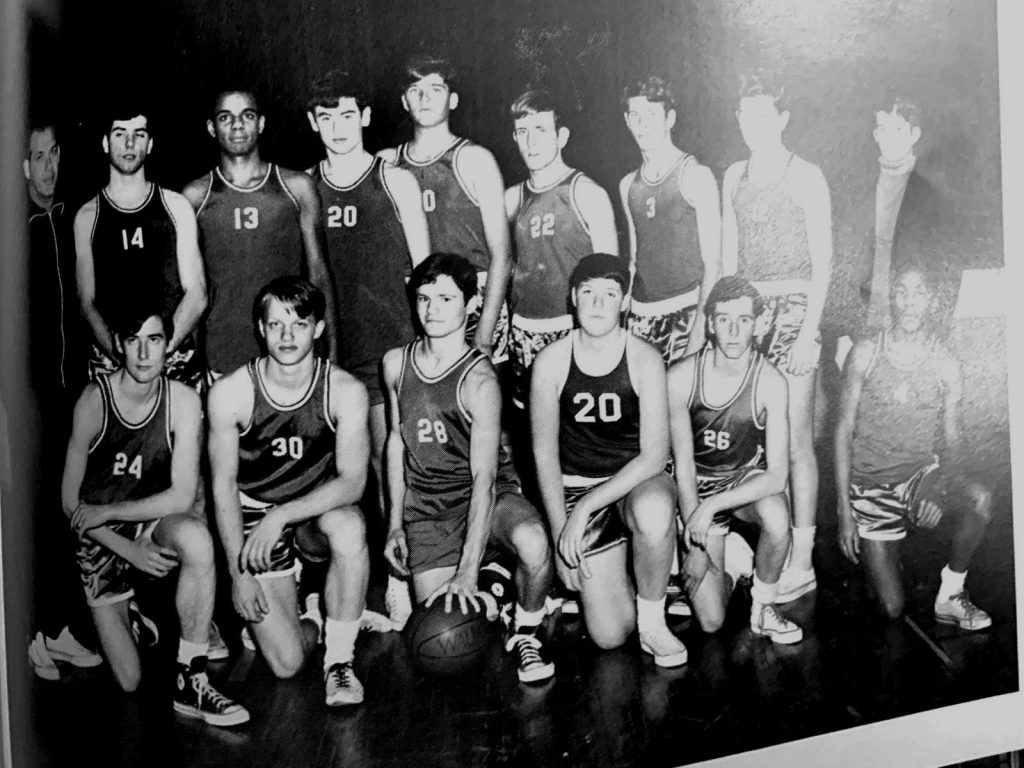
Ken Chenault, #13; Stephan Chenault, #4 (photo obscured); the author, #20
Ken and his brother were not, like too many African Americans, recruited by my private school in mostly white Garden City, for their basketball prowess. We lived in nearby Hempstead, where I was part of the white minority and went to an old Methodist church that was similar in complexion. It wasn’t until many years later that I found out that the AME church less than a block away had finally absorbed my old church after the white congregation’s numbers dwindled because members fled to the suburbs. As a young boy, I was clueless about this stark racial divide.
My parents wanted me to go to a private school rather than be the only white kid in the nearby elementary school now named Barack Obama Elementary. Subsumed like so many African American boys in a majority white school setting, however, Ken and his two brothers went on to negotiate the perils of American capitalism. The rest, as they say, is history.
So whatever your religious or political affiliation, I can tell you from personal experience that when someone like Ken Chenault speaks, please listen with an open mind. As for me, I’m still sitting on the bench in awe of the starters.
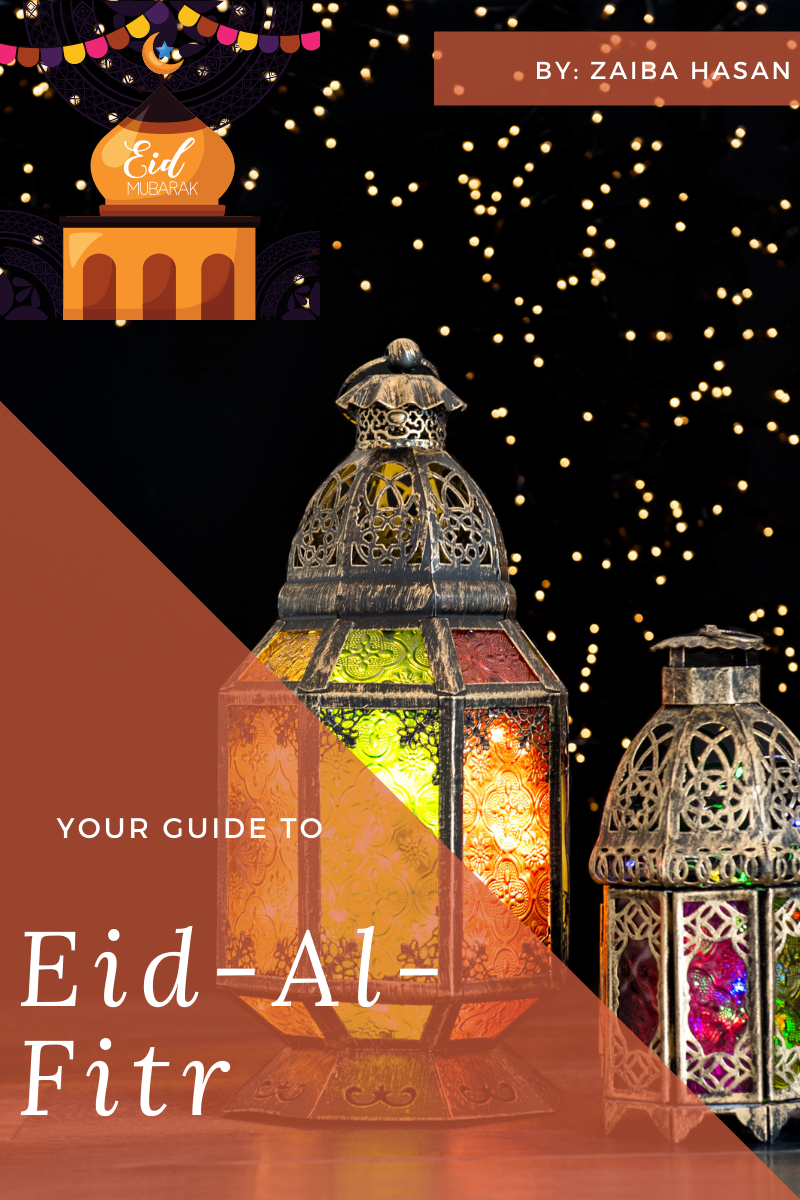
On May 13th, we Muslims will be celebrating our holiday called Eid-al-Fitr. Eid al-Fitr, also called the “Festival of Breaking the Fast” or Lesser Eid, is a religious holiday celebrated by Muslims worldwide that marks the end of the month-long dawn-to-sunset fasting of Ramadan. This religious Eid spans the first three days of the month of Shawwal and Muslims are not actually permitted to fast. You may be wondering, “why does this day change every year?” Great question! Similar to our Jewish brothers and sisters Muslims observe a Lunar calendar vs. a solar calendar which is only 355/356 days a year. This also explains why the observance or the calculation of the new moon (aka “the moon wars”) is important to Muslims as this determines the beginning of the following lunar month.
Muslims around the world celebrate in a variety of ways but all begin their day with a special Eid Prayer where we rejoice in our abundance. Pre-covid times when prayers were complete you’d hear “Eid Mubarak” or “Eid Kareem” as you turned and embraced the person who prayed right next to you, even if they were total strangers. In Muslim countries these days are national holidays where people visit friends and neighbors always with a sweet treat in hand. However, unfortunately that is not the case in the states, but our family has always made it a priority to take the day off and spend it in celebration, even if we continue to be in the minority. Our family focuses on three main components during this celebratory time, in addition to eating of course!
Philanthropy-All month-long we are encouraged to participate in charitable acts, whether you are donating your time or money. Being mindful of our family’s abundance is something we really strive to facilitate in our children. The Qu’ran specifically says: “Believe in Allah and his messenger, and give charity out of the (substance) that Allah has made you heirs of. For those of you who believe and give charity – for them is a great reward, ” this is officially known as Zakat-al-Fitr.
Forgiveness-Fasting is a physical tangible declaration of faith and in addition to that we are encouraged to seek forgiveness and to forgive as an opportunity to lighten your soul. Ramadan is not just the abstinence of eating/drinking, it is also the abstinence of bad thoughts, bad wishes, bad intentions. So our family motto is to live this truth throughout the year but especially during this month as a way of renewing our faith.
Family-When the craziness of the “everyday” scatters your family in all directions having a designated time of the year to reconnect is a blessing. Our family spends the day usually volunteering post-prayer, opening gifts, and did I mention eating. We use this day “off” (even if it isn’t recognized) to reset our intentions to God (Allah) and to each other. As we turn the page of another new (lunar) month, we wish you and your family a very Blessed Eid Mubarak.
Resources
Event Lists (Virtual and In-Person)
5/11/21 3-4pmest
Ramadan and Eid Storytime (splashthat.com)
5/13/21 10-1pmest
Eid ul-Fitr Salat & Celebrations — NWMI
Recipes
Recipes — Mind Body Soul Sisterz
Popular Children’s Books in Eid
Ramadan Around the World By: Ndaa Hassan
Under the Ramadan Moon By: Sylvia Whitman
It’s Ramadan Curious George By: Hena Khan
Night of the Moon By: Hena Khan
Festival of Eid By: Omar Khwaja
This blog post is the expressed opinion of its writer and does not necessarily reflect the views of Tysons Interfaith or its members.
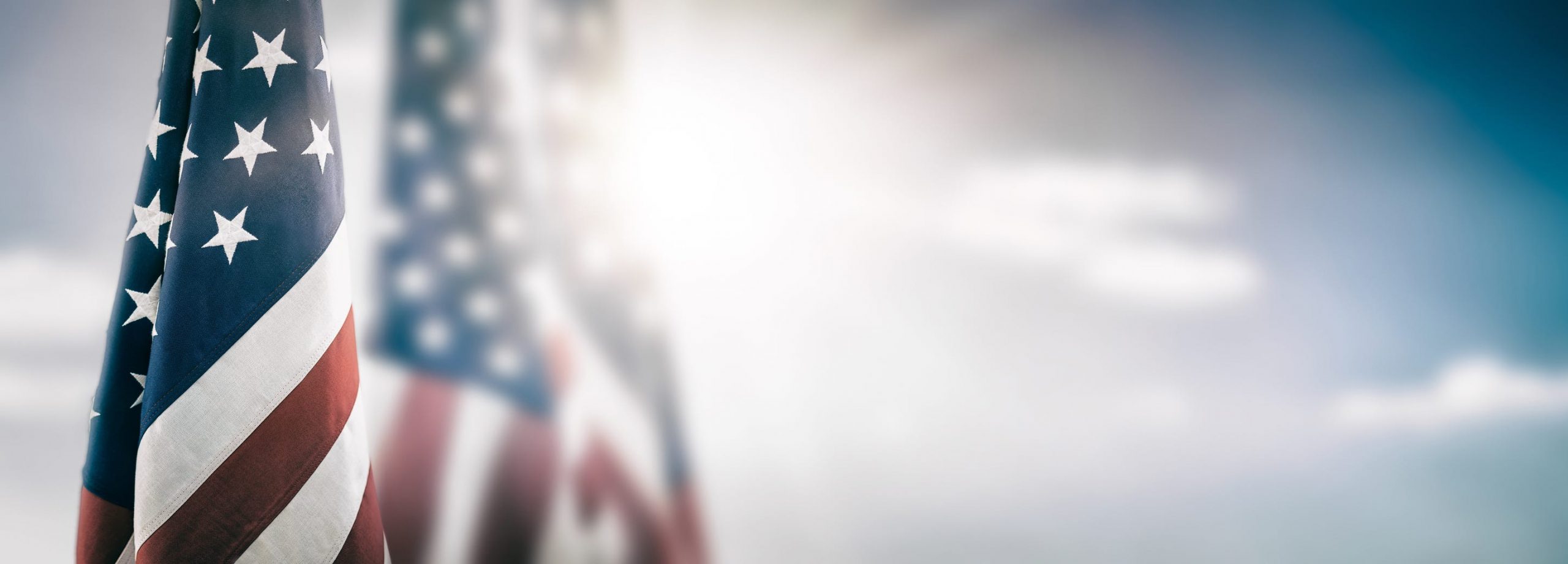
Just as we got ready for Passover, Easter, Ramadan and Norwuz, the Gallup organization raised eyebrows finding that fewer than half of Americans now belong to a house of worship, a downward trend that has persisted for some time. Gallup: Fewer than half of Americans belong to a church or other house of worship (religionnews.com) At the same time, there seems to be concern among the “nones” (i.e. those who have no religious affiliation), that as organized religion decreases, they had better watch out because they will face more and more legal oppression. This position is forcefully articulated by a young law professor named Tyler Broker. The Legal Oppression Of Nonbelievers Will Escalate The More Religion Declines | Above the Law
Well now. Hopefully this view is overly pessimistic while others see interesting possibilities for the nation’s religious future.
Wesley Graham-Michaelson, the former general secretary of the Reformed Church in America, has this to say about the Gallup poll:
“When nones are asked why they have disaffiliated from any religious organization, only 22% say it is because they do not believe in God. The primary challenge facing pastors, rabbis and imams is how to invite nonmembers into an authentic experience of God.” Behind Gallup’s portrait of church decline (religionnews.com)
And he notes that “color” and national origin matter:
“The nones who enjoy lattes at downtown coffee shops on Sunday mornings instead of singing in church are largely young, hip and white. But the country’s demographic future as a whole is becoming more racially and ethnically diverse, and this will impact the religious landscape.”
Lampooning aside, this is probably true in our Tysons community. The vibrant Korean-American churches you can find on our Tysons Interfaith map support the author’s point that immigration can actually increase religious participation. “Denominations rooted in Africa and Asia now have hundreds of congregations throughout the U.S., which continue to grow.”
The task, therefore, for faith communities in this changing world, seems to be to find ways to engage with non-affiliated “nones” to communicate that they are welcome, that the faith experience is relevant and has something to offer their lives. At the same time, we must reassure the non-practicing that faith communities such as those who are members of Tysons Interfaith, are strong supporters of all aspects of the First Amendment. Any perception of state sponsorship of religion is directly counter to the freedom to practice religion (or be agnostic). Admittedly it is tricky to juggle all the requirements of the First Amendment – to protect religious expression without crossing the line into perceived partiality for or even state sponsorship of religion. We can say, that at Tysons Interfaith, we are all about defending the freedom to exercise our various religious practices, while at the same time promoting spirituality, building community and cultivating respect and understanding among neighbors regardless of religious affiliation, race or culture.
This blog post is the expressed opinion of its writer and does not necessarily reflect the views of Tysons Interfaith or its members.

Next week, I will be getting my second Pfizer vaccination shot. Other than a sore arm for twenty-four hours (that proved to me something actually happened) I suffered no ill effects from the first shot.
I know there are people who are hesitating and even refusing to get vaccinated against Covid-19, and that they have a variety of reasons for this. I also know that I come from a relative position of privilege – that I do not have reason to distrust government and have not lived with substandard health care.
Given that, I still think it is important to share the reasons why I am getting vaccinated.
- I trust the science. The FDA granted Emergency Use Authorization for the Pfizer, Moderna and Johnson and Johnson vaccinations because after clinical trials, they scientifically concluded that the vaccines are safe enough to be used for this emergency – a global pandemic that has upended our lives and taken the lives of far too many of our loved ones: FDA Pfizer Announcement; FDA Moderna Announcement. For me, the fact that there was a pause of the Johnson and Johnson vaccination reinforces my belief that government scientists are being transparent and as careful as possible with our health. FDA Johnson and Johnson Suspension of Paulse Announcement. I trust that the vaccine developers and reviewers have brought their very best for us in this crisis and it is our best hope of truly ending it. Indeed, to me the fact that we have these weapons in our arsenal to combat the disease is nothing short of miraculous.
- Beyond trusting the science, I trust my own experience and what I have heard from friends and family who have received the Covid vaccine. Only one of my friends and one family member felt fluish after the second vaccination shot – but this resolved relatively quickly. Even a precious cousin who received the Johnson and Johnson vaccination before the pause, and who has underlying health conditions, suffered no ill effects, for which I am grateful. All of us who reported sore arms also have a sense of euphoria about being granted “super powers” to protect us from the likelihood of ever having to be hospitalized because of the Covid-19 killer.
- Even more than protecting my own health, my desire to protect my multi-generational household motivates me to get vaccinated. My mother and my husband are both in a more vulnerable category. I would move heaven and earth to keep them safe. Of course, I also appreciate the freedom I am gaining to be able to visit with vaccinated family and friends, and to move around in the world with more confidence that I will not get infected or infect others.
- Also for me, getting vaccinated is the least I can do for our health care professionals who have put their own lives on the line, and who continue to work tirelessly to heal and save as many of us as possible during this pandemic.
- Finally, getting vaccinated is an article of faith for me. My friend, the Very Rev. Fran Gardner-Smith wrote a blog post for Tysons Interfaith entitled, “Love your Neighbor” Wear a Mask.” In it, she said: “I understand Jesus’ teaching to mean that every law in scripture and every word of encouragement from the prophet to live rightly may be summed up in the actions of loving God and loving our neighbors. …..when Jesus says we are to love our neighbor, he’s not simply talking about the person who lives next door to us. He’s talking about all the people we encounter, known and unknown.” I am getting vaccinated as an act of love for my neighbor, whether they are next door or on another continent.
I hope and pray that in the end, the vast majority of my neighbors will weigh all the facts and come to this same conclusion that I did – that getting vaccinated is safe, smart, and a civic duty. More than that, it is an act of love toward our fellow humans, and the only way to truly end the Covid-19 pandemic.
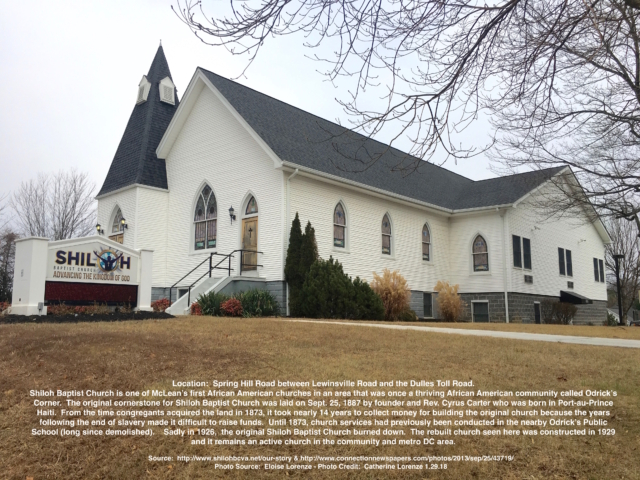
As Spring unfolds, the pandemic recedes, and it seems like we all can breathe just a little bit better again, our nation continues to reel from the storm winds of racial injustice.
Just last weekend, for example, at a special convention of the Episcopal Diocese of Virginia to which I am a delegate, we came oh so close to to allocating $1,000,000 from diocesan investment assets for “Reparations & Undoing White Supremacy.” While many Episcopal Dioceses around the country are taking similar steps, to my personal disappointment, our resolution failed to pass this time around. Our Bishop had this to say about it: “Budget Resolution 4 is bold in scope and strong in intent, “said Bishop Goff. “In coming months, I look forward to working with groups in our Diocese to identify sources of funding and achieve greater clarity about how funding would be used. God bless us as we explore and act together.” Read more here. To read more about the national Episcopal Church’s work for racial healing, you can visit here.
Closer to home, I’ve been thinking about how Tysons could somehow, even in a small way, contribute to the conversation. Bear with me as I tell you about how our neighborhood has a rich African American history that rivals old man Tyson’s.
Just down the road from Tysons is Odrick’s Corner. (Well, the sign painters take the apostrophe out most of the time.)
Who was this dude with the unusual name? Turns out he was a carpenter who lived in Herndon, and he was a freed slave who in the era of Jim Crow managed to save enough money to buy thirty acres of land at the corner of Lewinsville and Spring Hill Roads and build a schoolhouse for African American children and a church, now Shiloh Baptist, a member of Tysons Interfaith! You can find the original gravestones behind the McLean Hamlet residential subdivision. Additional photos here.
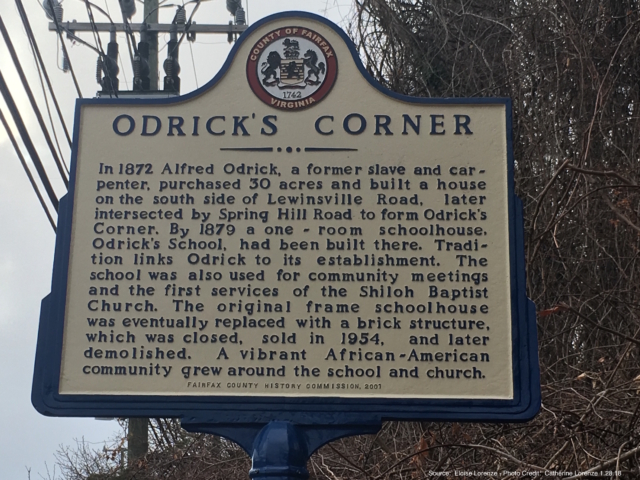
And up Lewinsville Road toward my church you can find a small architectural and spiritual wonder in the form of Historic Pleasant Grove, a Methodist church also built by skilled African American carpenters. It is now a museum and meeting space. I recommend you learn about its history and special events and the wonderful folks whose ancestors are buried in the well-kept graves. Additional photos here.
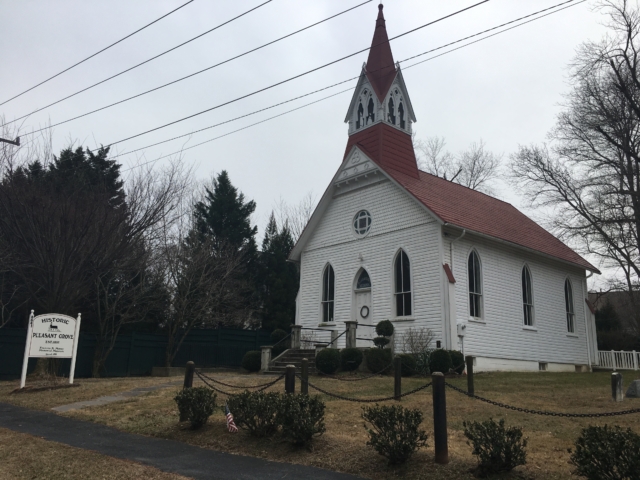
And then there’s the First Baptist Church of Chesterbrook McLean, which vies with Shiloh Baptist as being the oldest African American church in the area. Oldest Black Church in Fairfax Recalls Roots. I met the former pastor and mother of the current pastor at a Share of McLean meeting a few years ago. She grew up on Ball’s Hill Road and told me that whenever it rained, she would have to get out of the school bus at Scott’s Run, now the McLean Metro stop, and use a stick to see how deep the water was on Chain Bridge Road before the driver could proceed to take her home!
So, when you walk or ride around Tysons, think about those African American roots. And then there’s those Native Americans…but that’s another story.
This blog post is the expressed opinion of its writer and does not necessarily reflect the views of Tysons Interfaith or its members.
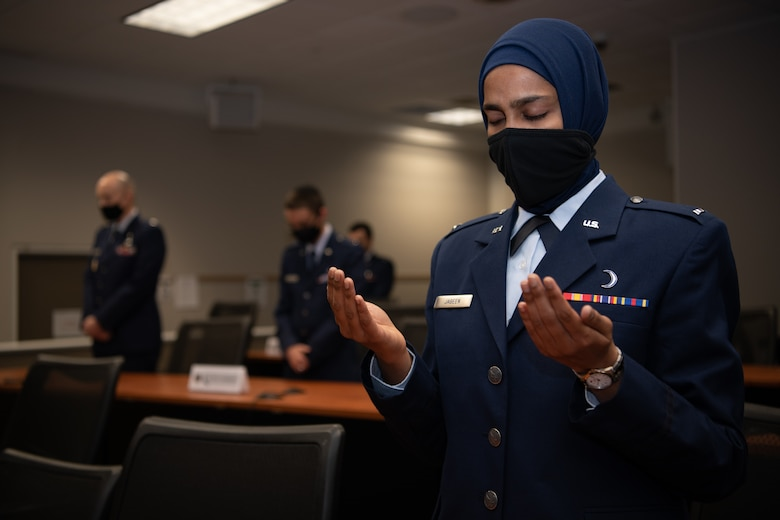
By: John Fairfield, Lieutenant General USAF (Retired)
(Air Force photo by Airman 1st Class Jackson Manske)
In February, 1st Lt. Saleha Jabeen became the U.S. military’s first female Muslim chaplain, graduating from the Air Force Basic Chaplain Course at Maxwell Air Force Base.
The following is extracted from an Air Force article about her: https://www.af.mil/News/Article-Display/Article/2506448/first-female-muslim-chaplain-graduates-from-air-force-chaplain-corps-college/
Jabeen, a native of India, said she was grateful for the opportunity and aware of the responsibility she has to set an example and show that there is a place in the military for anyone who wants to serve.
“I did not have to compromise on any of my religious beliefs or convictions,” Jabeen said. “I am surrounded with people who respect me and are willing to receive what I bring to the table as a woman, a faith leader, and an immigrant. I am provided with numerous opportunities to learn and develop skills that best equip me to be a successful officer and a chaplain in a pluralistic environment. I get to provide spiritual care to all service members, guardians and families and advise the commanders on religious and moral matters regardless of my faith, ethnicity or gender. Like our boss says, it has never been a better time to serve as a chaplain in the U.S. Air Force Chaplain Corps.”
Jabeen is passionate about her role as a chaplain and takes her duty as a spiritual mentor seriously.
“We all have a purpose that is specifically meant for us to fulfill,” Jabeen said. “We must listen to our heart and follow our conviction. It is important to have people in our lives who model that for us. Choose that kind of mentorship and choose good companionship. I just want people to remember that God, or higher power or the values that people uphold, remind us that we are all created with a plan: to become the best versions of ourselves. There is a ‘why’ for our existence and ultimately it is meant for us to be the best versions of ourselves. Commit to it, accomplish it and uplift others to do the same. Do all that needs to be done with kindness, generosity, resilience and the grit to never quit.”
We congratulate Lieutenant Jabeen and salute her for her service.
Won’t it be nice when we will not have to use the word “first” when considering gender, religion, or race?
This blog post is the expressed opinion of its writer and does not necessarily reflect the views of Tysons Interfaith or its members.

I remember the first bird that piqued my interest in taking up the hobby of birding —it was the strangest thing I’d ever seen! It about thirty years ago, and this fellow was sitting as still as you please under a tree in my backyard. I was able to draw a terrible rendering of it and mailed it to a birder friend. After she finished laughing at my artistic skills, she wrote back and said it appeared to be a Northern Flicker, and it was a very good bird to see in the backyard. I went to the yellow pages to find a local bird store (did such things exist? yep, they did), marched in, bought a field guide and some binoculars, and signed up for classes. I was hooked.
Over the years, I became known as the bird mom at my children’s school — I would teach them about bird song (ask me sometime about the bird clock chorus lesson) and migration, about creating bird friendly habitats in their own backyards, and how to make their own bird feeders. I would take small groups of them out to a local lake and show them the beautiful spring warblers with their vibrant colors, the thrushes with their musical instrument-like songs, the tiny nests of the hummingbirds and the funny ground nests of the killdeer, and the raptors and other large birds that were always hanging around in the shadows, or way up in the sky.
One of the things I learned when I did my research for these lessons came from my great grandmother’s King James Bible, with its pages falling out. There was a section at the back entitled “Aids to the Student of the Holy Bible,” and in the section about animals and creation, it had this ponderous statement about birds: “The creation birds is placed in Genesis after that of fishes and reptiles, and before mammals, in exact accord with what paleontology has indicated.” The kids thought that was way cool! (So did I; this Bible had to have been printed well over 100 years ago.)
The grounds of the Church of the Holy Comforter offer a phenomenal habitat for our avian neighbors, especially now that we’ve begun to clear the non-native plants while leaving those that birds and insects depend on for food, nesting, and shelter. I’d encourage you to stop by the church early in the morning some day and sit on one of the benches by the labyrinth (or walk the labyrinth — just don’t put on your earphones and listen to music while walking!) Listen to the songs, to the chattering and chipping, to the skittering through the grass and the trees. Come again in the evening, at dusk, and you’ll hear all different songs and sounds (again, ask me about that bird clock chorus!) Close your eyes. Breathe.
Lots of folks at Holy Comforter like to talk about “thin spaces”, which to me means places where the distance between heaven and earth, between God and me, feels thinner, feels closer. I’ve just described to you what the everyday thin space is like to me — the grounds of the sacred space where my church family will someday come together again, in the company of those creatures that defy gravity and soar above us, singing their own praises to the same God. This is bliss.
This blog post is the expressed opinion of its writer and does not necessarily reflect the views of Tysons Interfaith or its members

My eighty-seven-year-old mother is an incredible gardener. Until she gave up her own home in rural Maryland and moved in with my husband and me in McLean (just on the edge of Tysons), she had an exceptionally large vegetable and flower garden that my siblings and I loved to raid each summer and the grandkids loved to explore. Once Mom moved to McLean, we just had to continue the tradition. Brothers were enlisted to help build several raised garden beds in our back yard. Since then, Mom and I have been successfully raising lettuce, spinach, Swiss chard, kale, arugula, beets, tomatoes, peppers, green beans, jalapenos, apple mint, basil, parsley, and other herbs. Not only does it help with grocery bills, but the food is delicious. We both enjoy being out of doors and working in the yard. It can be a workout, and watching God’s amazing variety of vegetation grow is a real joy.
Not everyone lives in a situation where there is room for backyard beds, but there are other ways to garden for those who might be interested. You can start small – just a few pots. Also, the Fairfax County Park Authority rents more than 650 garden plots in nine county parks on an annual basis to Fairfax County residents. Information about this program can be found by visiting https://www.fairfaxcounty.gov/parks/green-spring/plots
If you think you, your family, friends, work colleagues or spiritual community are interested in starting your own community garden, Fairfax County also provides these resources: https://www.fairfaxcounty.gov/topics/community-gardening and https://www.fairfaxcounty.gov/food-council/urban-agriculture/edible-gardens-resources.
Local non-profits, such as SHARE and Food for Others, are happy to receive donations from community gardens. Information about Food for Others’ Farm to Family program can be found at: https://www.foodforothers.org/farm-to-family-program. The link to SHARE’s produce donation program can be found at shareofmclean.org/community-garden (The SHARE program is on hiatus during the pandemic.)
For home gardeners who may be interested in sprucing up their landscape and learning about native plants, a great place to visit is Green Spring Gardens, a national historic site, museum, and outdoor classroom. https://www.fairfaxcounty.gov/parks/green-spring. Also, there is the nearby Meadowlark Botanical Gardens. https://www.novaparks.com/parks/meadowlark-botanical-gardens.
Finally, if you are looking for an opportunity to be out-of-doors and experience beautiful gardens, check out Virginia Historic Gardens Week. This is an annual event sponsored by the Garden Club of Virginia. This year it runs April 17 – 24. Tours of private landscapes, public gardens, and historic sites are offered by local member clubs throughout the Commonwealth. Tickets are required and available for purchase at https://www.vagardenweek.org/.
Happy gardening!
This blog post is the expressed opinion of its writer and does not necessarily reflect the views of Tysons Interfaith or its members

Just about every spiritual path celebrates spring in a special way. For those of us who follow the Sikh way of life, in spring, we celebrate our most auspicious holiday, called Baisakhi. This year, Baisakhi is celebrated on April 13th.
The Sikh way of life was established by ten successive Sikh Gurus in India. Each of them was a pure channel of God’s love and wisdom. They inspired people to live lives of devotion, service and joy – to live in God-consciousness. “Sikh” means “student of Truth.” Guru Gobind Singh Ji was the tenth Sikh Guru in human form.
In mid-April, 1699, at the spring festival called Baisakhi, Guru Gobind Singh Ji initiated a special baptism of the most devoted Sikhs, in which he prepared and served a divine nectar called Amrit. Through this baptism, the deeply devoted Sikhs became Khalsa, or pure ones. After the Guru baptized the first five Khalsa, he had them baptize him as well. Guru Gobind Singh Ji declared that whenever five Khalsa gather in his name, he would be there with them.
Baisakhi is the highest celebration for Sikhs. It is a time of rededication and renewal of our faith. Many people take part in this special baptism to become Khalsa at this blessed time of year.
This blog post is the expressed opinion of its writer and does not necessarily reflect the views of Tysons Interfaith or its members.
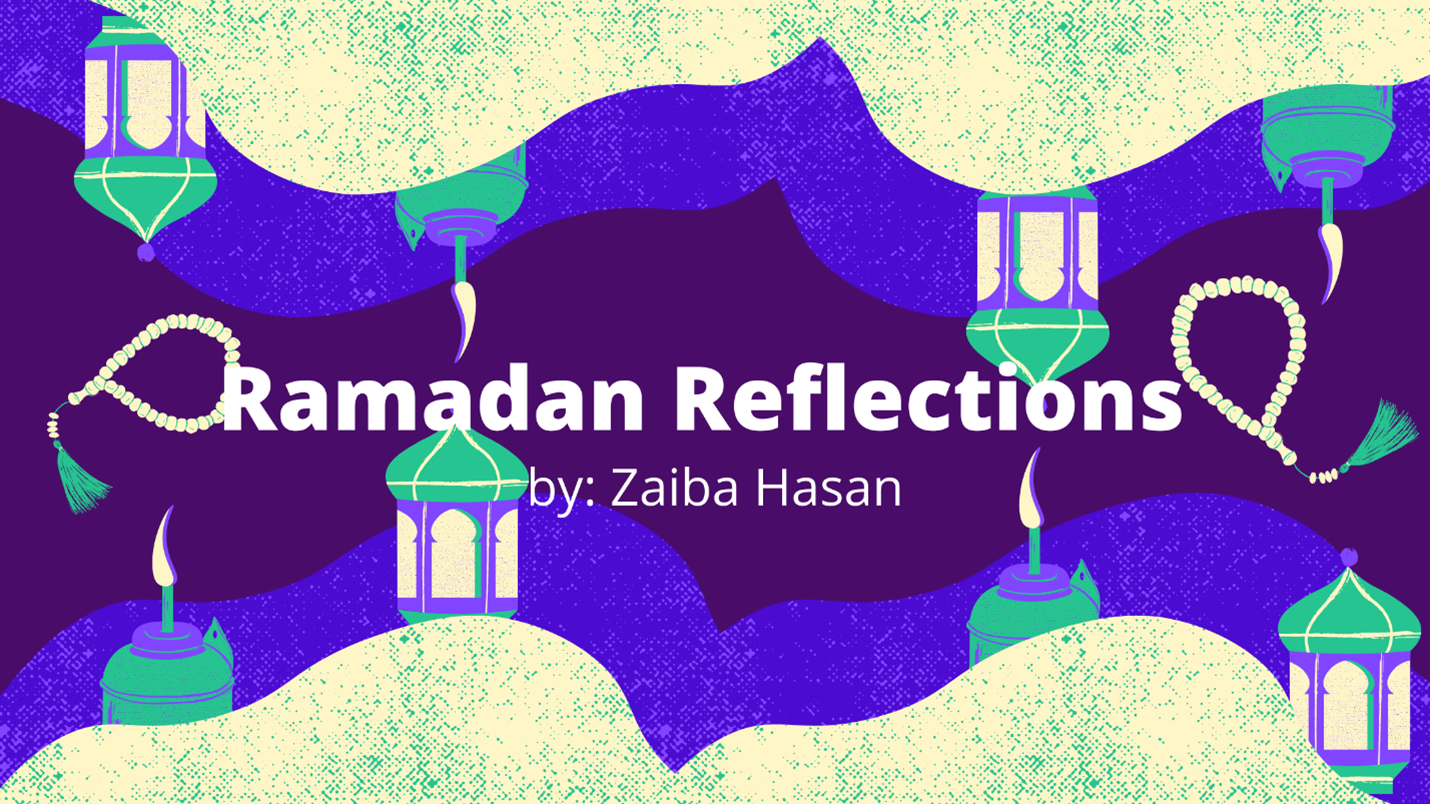
Monday, April 12th, 2021 marks the ninth month in the Islamic calendar when for thirty days, over 3.5 million American Muslims will fast and “yes, even forego water.” Ramadan for Muslims world-wide not only is one of our five pillars[1] or religious tenets, it is also an opportunity to reset, renew, and rejuvenate your spiritual connection to God (Allah) and use the physical pangs of abstinence, hunger, thirst during the daylight[2] hours as a tangible reminder of your spiritual connection to something bigger than your body’s physical needs. However, as a religious minority it is often harder for us to do this. Living in a non-Muslim community means that we are squeezing in prayers between work meetings, breaking your fast at your son’s baseball games, or “listening” to the Quran[3], at stoplights while rushing to your next appointment. Not necessarily conducive to that whole spiritual awakening we are supposed to be experiencing. For our family, knowing that we cannot stop our every-day lives to dedicate it solely to religious practices, we try to fit in the intent behind Ramadan in a more practical application whenever we can.
Charity: As one of the main five tenets fitting in additional charitable efforts during this month can be a welcomed experience to all. After supporting our local Mosque, our family usually chooses a few charities to support either financially or with our physical time. In volunteering we are taking the meaning behind this month of connection to reconnect with ourselves as a family and to connect with the community as well. (Note: we are supporting St. Jude Children’s Research Hospital and you all are invited to our virtual iftar.)
Interfaith: My personal philosophy has always been that we are more alike than different, and in celebrating our differences we can view them as a rich opportunity for learning and growth. We are bridging that gap of misunderstanding one smile, one greeting at a time and potentially creating a village of allies that we all need during these rocky times. Use this month as an opportunity to take a treat to your neighbor, read a Ramadan book to your child’s class, write a blog in your local community. Make our presence known because it is a lot harder to hate when there is a person sharing their samosas with you.
Reflection: In using the momentum of Ramadan as a springboard to further reflection. How can we continue doing good works for a local community? How can we make small changes of understanding to further close the gap of misunderstanding? How can we as a family come together and with our own hands help the hungry, care for our neighbor, reconnect with God (Allah) in a way that is more meaningful than rushed prayers in between activities?
Maybe celebrating Ramadan here is not as easy as it would be in a Muslim country. However, I would argue that it is more meaningful. We as a Muslim community must work that much harder to implement and institute our religious traditions in a non-Muslim country. In making space for ourselves now, we are also making space for others that come behind us. If that is not in the spirit of Ramadan than I don’t know what else is.
Until Next Time,
This blog post is the expressed opinion of its writer and does not necessarily reflect the views of Tysons Interfaith or its members.
[1] Shahada (profession of faith), Salat (prayer), Zakat (charity), Saum (Fasting), Hajj (pilgrimage)
[2] Muslims refrain from food, water, and sexual relations from sunrise to sunset.
[3] Muslims holy text
